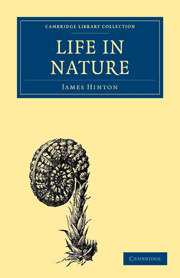Book contents
- Frontmatter
- Contents
- INTRODUCTION
- CHAPTER I OF FUNCTION; OR, HOW WE ACT
- CHAPTER II OF NUTRITION; OR, WHY WE GROW
- CHAPTER III OF NUTRITION; THE VITAL FORCE
- CHAPTER IV OF LIVING FORMS; OR, MORPHOLOGY
- CHAPTER V OF LIVING FORMS; THE LAW OF FORM
- CHAPTER VI IS LIFE: UNIVERSAL?
- CHAPTER VII THE LIVING WORLD
- CHAPTER VIII NATURE AND MAN
- CHAPTER IX THE PHENOMENAL AND THE TRUE
- CHAPTER X FORCE
- CHAPTER XI THE ORGANIC AND THE INORGANIC
- CHAPTER XII THE LIFE OF MAN
- CHAPTER XIII CONCLUSION
- APPENDIX: AN ATTEMPT TOWARDS A MORE EXTENDED INDUCTION OF THE LAWS OF LIFE
CHAPTER V - OF LIVING FORMS; THE LAW OF FORM
Published online by Cambridge University Press: 29 August 2010
- Frontmatter
- Contents
- INTRODUCTION
- CHAPTER I OF FUNCTION; OR, HOW WE ACT
- CHAPTER II OF NUTRITION; OR, WHY WE GROW
- CHAPTER III OF NUTRITION; THE VITAL FORCE
- CHAPTER IV OF LIVING FORMS; OR, MORPHOLOGY
- CHAPTER V OF LIVING FORMS; THE LAW OF FORM
- CHAPTER VI IS LIFE: UNIVERSAL?
- CHAPTER VII THE LIVING WORLD
- CHAPTER VIII NATURE AND MAN
- CHAPTER IX THE PHENOMENAL AND THE TRUE
- CHAPTER X FORCE
- CHAPTER XI THE ORGANIC AND THE INORGANIC
- CHAPTER XII THE LIFE OF MAN
- CHAPTER XIII CONCLUSION
- APPENDIX: AN ATTEMPT TOWARDS A MORE EXTENDED INDUCTION OF THE LAWS OF LIFE
Summary
These few instances, which might be indefinitely multiplied, may suffice to make it manifest that organic forms are to be ascribed to causes essentially the same as those which regulate the forms of inorganic bodies: in short, to the laws which force obeys wherever it is found. The peculiar structure which living bodies assume is due to the mechanical conditions under which they are placed, and not to a peculiar power operating to that special end. That peculiar power is, indeed, disproved, if further disproof were needed, by the existence of monstrosities and deformities, in which the end is not attained. The case is like that of the old doctrine that nature abhorred a vacuum. It was found that this was true only to a certain extent, and to varying degrees; just so does the special formative power supposed in living bodies produce peculiar forms only to a limited and varying degree of accuracy.
A word may be said here, also, respecting the doctrine of “types,” or standards, to which all living forms are referred. As a guide to the investigation of the organic world, this idea has proved itself invaluable; and the doctrine of corresponding parts in different organisms, to which it has been made subservient, constitutes, and must continue to constitute, a beautiful branch of physiological science. But it is hardly necessary to say that no formative power is to be ascribed to those types or standards.
- Type
- Chapter
- Information
- Life in Nature , pp. 108 - 124Publisher: Cambridge University PressPrint publication year: 2009First published in: 1862



